The restaurant industry is a significant contributor to the national economy and its importance has been increasing over decades. According to the National Restaurant Association (NRA), the restaurant industry contributes 4% of the national Gross Domestic Product. The NRA also reports that the restaurant industry accounted for 25% of the total food dollar in 1955 and this increased to 47% of the national food dollar by 2016. Restaurant industry growth in real dollars is charted in the table below.

restaurant Industry Review
Some social trends related to restaurants as noted by NRA include:
- Women owned restaurants increased by 40% from 2007 to 2012.
- Hispanic owned restaurants increased by 51% from 2007 to 2012.
- Half of all consumers indicate that restaurants are an essential part of their lifestyle.
- 80% of consumers prefer to dine out with family and friends rather than cook and clean.
In the State of Arizona restaurants account for $11.5 billion in annual sales. There were 9,176 restaurants in the state in 2014 and 282,700 jobs were provided in the industry in 2016 (Arizona Restaurant Association).
Number of Restaurants
The GDP Group publishes a semi-annual count of all restaurants in the United States. According to GDP there were 629,488 restaurants in the country as of February 2016. Chain restaurants experienced positive growth of 1% from September 2014 to September 2015 with 292,943 chain units operating nationally in September 2015. Independent operators experienced a slight decline in the number of units decreasing by 2% from September 2014 to September 2015. The table below shows the number of restaurants within the Top 5 U.S. metropolitan areas.
Interestingly, northern or Snow Belt cities (New York and Chicago) have had declines in the number of restaurants while the cities in the Sun Belt have experienced increases.
Company Review – Buffalo Wild Wings
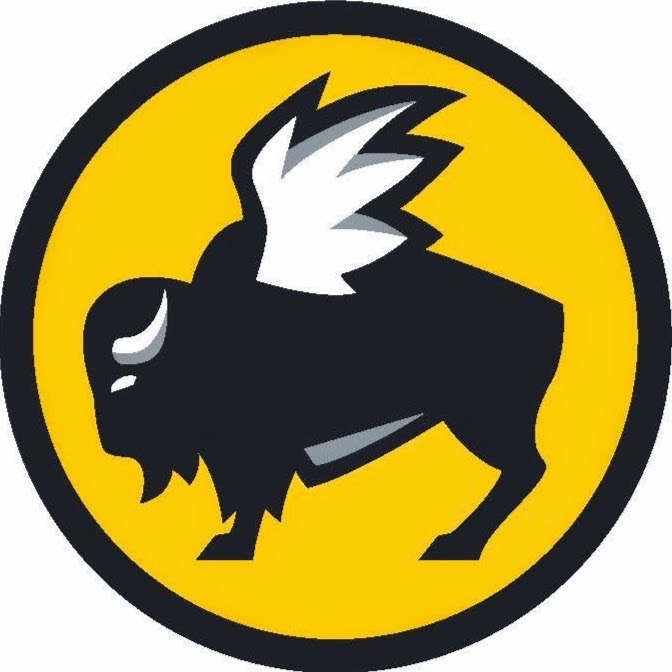 History and Overview
History and Overview
Buffalo Wild Wings has made a significant investment in Arizona, with 21 stores in the state. Of these, 3 are located in Tucson. Buffalo Wild Wings started in 1982 near Ohio State University. The company offered its first franchise operation in 1991 and went public in 2003. It has now grown to nearly 1,200 company owned and franchised stores. Of these 596 are owned and 576 are franchised. The two main concepts are wings and a sports bar environment. In fact, wing sales account for 42% of total revenue. Alcohol sales account for 20% of gross revenue. Each newly opened store provides over 60 flat screen and projection televisions. The company has 44,500 employees. Almost all of their restaurants are in the United States with 14 in Canada, 10 in Mexico, and the rest in Asia or the Middle East.
Financial Results
Revenue for company operated stores and net income from all operations are noted in the table below.
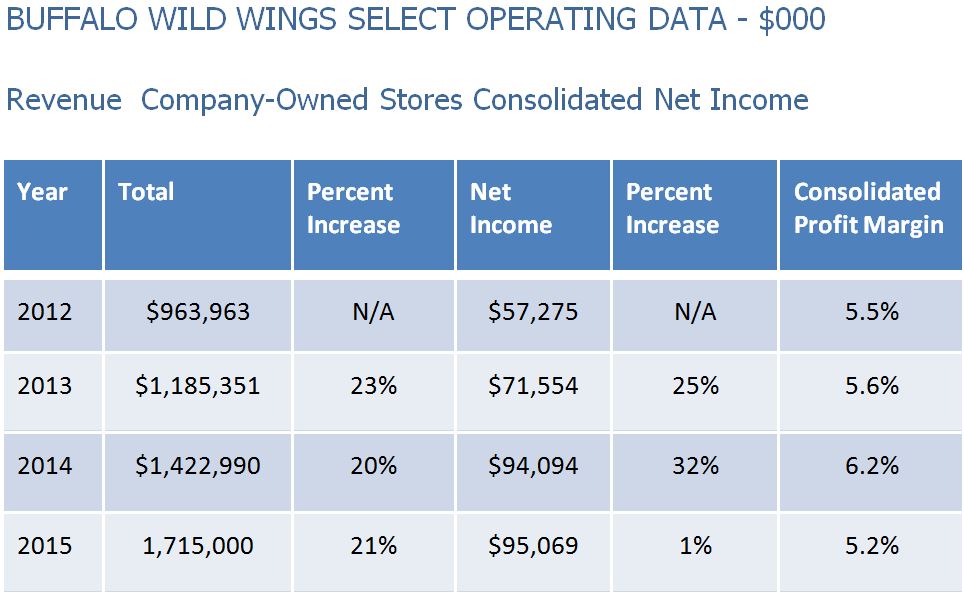
Company growth has occurred almost exclusively through new store openings although revenue per store for company owned stores increased by 4.2% in 2015. As noted, there has been consistent net income ranging from 5.2% to 6.2%. Other key operating statistics include:
- Revenue from company owned stores averaged $2,877,517 in 2015, or $464 psf.
- Revenue from franchised stores averaged $3,330,216 in 2015 or $537 psf.
Real Estate
Buffalo Wild Wings owns, leases, and ground leases its real estate. The company primarily targets either freestanding pads with high profile frontage or end-cap spaces. In select instances urban redevelopment opportunities are sought in existing mixed-use projects. Leases are usually structured at from 10 to 15 years with long-term options. Leases are usually NNN. Key site selection criteria include:
- Proximity to other retail developments in retail corridors.
- Visibility, signage, and access.
- Location within a “restaurant corridor”.
The company reports that the average investment for a new location is $2,300,000 or $370 psf. Existing restaurants range in size from 3,900 to 11,200 sf with an average of 6,200 sf. Future prototypes are planned at from 4,000 to 6,500 sf. Direct construction costs, excluding site cost, range from $175 to $325 psf. Furniture, fixture, and equipment packages range from $634,000 to $1,395,000. This is higher than usual for a casual dining restaurant due to the significant amount of audio visual equipment and sports memorabilia.
Tucson restaurant Price Trend
Tucson price trend information for the five year period from 2011 through 2015 is provided in the table to the right. This pricing is for all restaurants, fast food, casual, fine dining, and other concepts. 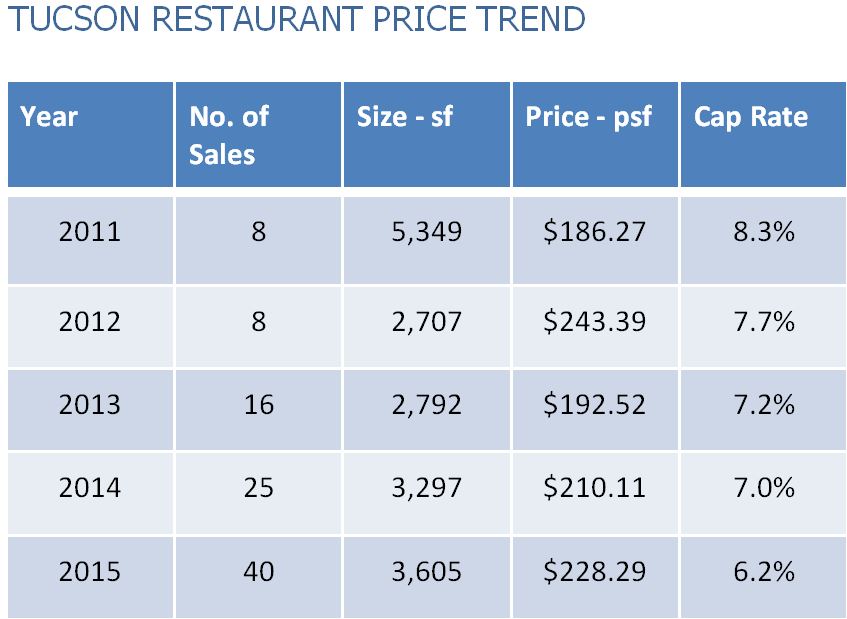 The data for the years 2011 through 2013 is not statistically significant as the city’s economy was recovering from the economic collapse of the mid and late 2000s. Information for 2014 and 2015 is more relevant and is consistent with research and appraisal work conducted by AM Valuation Services, PLLC, in the Tucson area. There were 25 sales during 2014 and 40 sales reported for 2015. The other averages for the period with regard to price and cap rate indicate that the market may be experiencing moderate upward pressure on values. The average price increased from $210.11 psf in 2014 to $228.29 psf in 2015. The average cap rate declined during the same time period from 7.0% in 2014 to 6.2% in 2015.
The data for the years 2011 through 2013 is not statistically significant as the city’s economy was recovering from the economic collapse of the mid and late 2000s. Information for 2014 and 2015 is more relevant and is consistent with research and appraisal work conducted by AM Valuation Services, PLLC, in the Tucson area. There were 25 sales during 2014 and 40 sales reported for 2015. The other averages for the period with regard to price and cap rate indicate that the market may be experiencing moderate upward pressure on values. The average price increased from $210.11 psf in 2014 to $228.29 psf in 2015. The average cap rate declined during the same time period from 7.0% in 2014 to 6.2% in 2015.
Tucson restaurant Construction
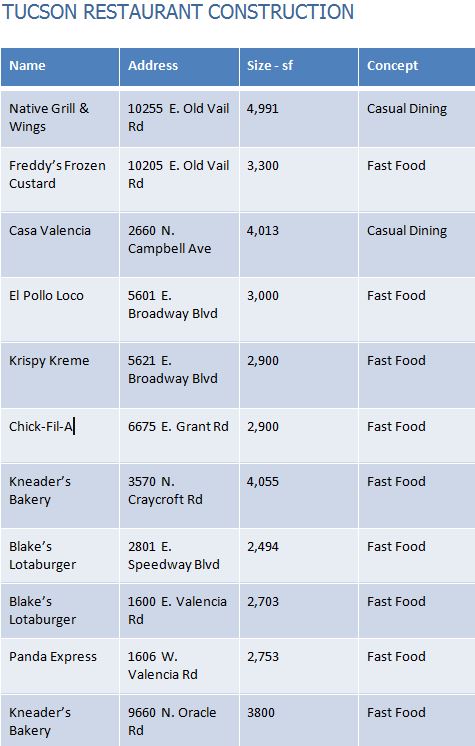 The City’s economy and real estate markets have been in gradual recovery for several quarters. Cushman & Wakefield | PICOR (PICOR) reports that 129,000 sf of retail space was under construction Tucson as of second quarter 2016. Also as of second quarter, PICOR reports that the retail vacancy rate in Tucson was 6.4%. Restaurant construction is a significant part of new real estate activity, whether considering leasing, sales, or new construction. New construction city-wide is detailed to the right for restaurant properties.
The City’s economy and real estate markets have been in gradual recovery for several quarters. Cushman & Wakefield | PICOR (PICOR) reports that 129,000 sf of retail space was under construction Tucson as of second quarter 2016. Also as of second quarter, PICOR reports that the retail vacancy rate in Tucson was 6.4%. Restaurant construction is a significant part of new real estate activity, whether considering leasing, sales, or new construction. New construction city-wide is detailed to the right for restaurant properties.
In the industry overview provided earlier it is noted that the national chains are expanding while independent operators are contracting slightly. This is clearly evident in the Tucson construction activity as 8 of the 10 companies noted are franchise or corporate operations. The two exceptions are Casa Valencia and Blake’s Lotaburger. Blake’s is a New Mexico based chain with 77 stores that is expanding into Texas and Arizona. Casa Valencia is a local restaurant. Two interesting anecdotes relative to the projects noted above include:
- A press release for Krispy Kreme states that 150 jobs will be provided. This is a return to Tucson for Krispy Kreme as they previously closed their Tucson operations.
- Blake’s Lotaburger, the noted independent chain, apparently makes the best “Green Chile Cheeseburger” in the World, according to National Geographic.
Tucson Neighborhood Spotlight
Tucson has many niche retail areas with concentrations of restaurants. The La Encantada shopping center in the Foothills is probably the best retail destination point in Tucson. It is located at the north-end of Campbell Avenue at Skyline Drive. It is an open or outdoor center that has dramatic views of the Tucson valley and the Catalina Mountains. Nearby housing prices are among the highest in Tucson. Due to these characteristics La Encantada has several dining concepts. There are other food service concepts including Savaya Coffee, AJ’s, Frost Gellato, and Teavana. Only the full service facilities are reviewed here.
North occupies a freestanding pad and has dramatic city and mountain views with patio seating and a full-service bar. Firebirds also occupies a pad site but the views are not as dramatic. There is also a full-service bar at Firebirds. Humble Pie occupies a rear space but has city views and also provides a full service bar. RA Sushi is in an end unit and has somewhat limited views. Blanco occupies a patio oriented space and like North has dramatic views with a full service bar that opens-up onto its patio. Each of these concepts occupies well-appointed space with significant and unique tenant improvements. AJ’s (Purveyor of Fine Foods), it should be noted, fits in well with these dining concepts as this upscale grocery chain provides 5 limited service dining concepts. These include a Sushi bar, brick-oven pizzas, sandwiches and wraps, a bistro, and a bakery. These are primarily carry-out services but there is onsite patio seating as well as limited seating at the Sushi bar.
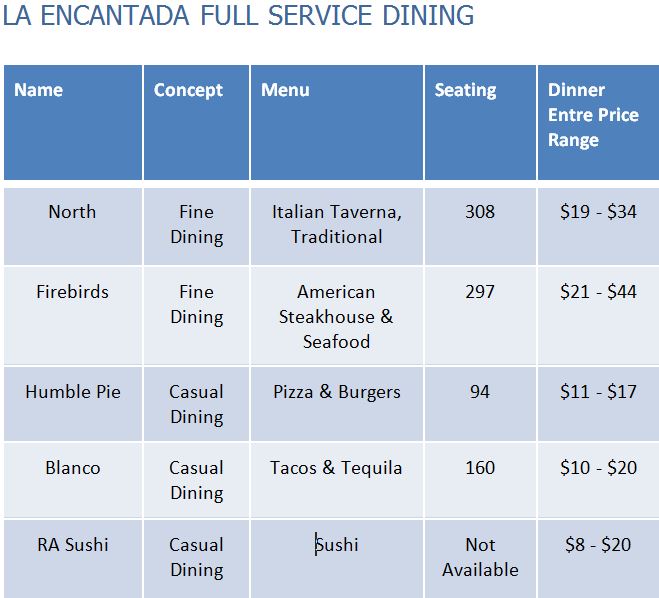
Recently Appraised Restaurants
The restaurant market has been more active than in years past. In addition, banks have been more willing to lend on restaurants. Here follows a list of some recently analyzed restaurants and their locations in Arizona: Starbucks, Flagstaff; Oracle Inn, Oracle; Church’s Chicken, St. Michael’s; Taco Bell, Shiprock; Los Betos, Sierra Vista; Carl’s Jr., Apache Junction; The Maverick, Macayo’s, Yoshimatsu, O’Malleys Bar & Grill, The Hut, Tucson; Burger King, Dairy Queen, Yuma.
 Ajay S. Madhvani is owner of AM Valuation Services, PLLCand has been a commercial real estate appraiser since 2004. Ajay has experience in all commercial property types, including restaurants. Ajay is licensed in the States of Arizona, New Mexico, and Utah.
Ajay S. Madhvani is owner of AM Valuation Services, PLLCand has been a commercial real estate appraiser since 2004. Ajay has experience in all commercial property types, including restaurants. Ajay is licensed in the States of Arizona, New Mexico, and Utah.
Sources: National Restaurant Association, GDP Restaurant Group Count, BWW Annual SEC 10K Reports, Cushman & Wakefield | PICOR, CoStar, Public Records, independent research by AM Valuation Services, L.L.C.




